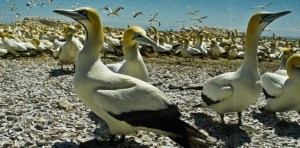TALK REPORT FOR JANUARY 2017
-Andrea Benn
21 January 2017: Cuan McGeorge on “The adaptability of an endangered species – the African penguin”.

Stony Point is the site of the only growing colony of African penguins on the South African coast. African penguins may be little smelly and noisy for some of their human neighbours, but they arrived in Betty’s Bay and formed the first mainland colony in 1982, some three years before the colony at Boulders Beach in Simonstown began.

When we built our cottage at Betty’s Bay in the early nineties, we would often take visitors from Europe and elsewhere to enjoy sundowners on the little deck overlooking the colony as the penguins came waddling back to their nests after a good day’s fishing. At the time, the fencing was limited to the nesting area and there was a small donations box built into the stonework. There was just a sandy track where the well-trod boardwalk now stands. The amazement and wonder our guests displayed at the idiosyncrasies of these flightless, heavy-boned birds gave us a deeper appreciation for what we are privileged to have on our doorstep.
Senior Marine Ranger Cuan McGeorge is responsible for overseeing the Stony Point Nature Reserve and the welfare of its quirky inhabitants. His passion and love for his work was clear in the informative and engaging talk he offered on 21 January 2017.

Cuan’s talk included the range of statistics that are necessary for recording and updating information on African penguins around the southern African coastline, from Namibia, around Cape Town, and on up to Durban. One of four species of black and white penguins in the southern hemisphere, our African penguins are not found in Australia or New Zealand.
African penguins rely on three fundamental factors for survival:
- Food
- Shelter
- Security
A negative impact on any one of these factors results in a decline in numbers.
Food
African penguins take their cue from keystone bird species such as terns, which are splash divers, or cormorants and gannets, which are deep divers. Observing the behaviour of these bird species on the water’s surface, penguins then dive down as deep as 30 metres to feed on the fish. One wonders whether penguins, terns, cormorants and gannets team up like the honey guide and the honey badger.



The main fish species on which African penguins prey are mackerel, anchovies and sardines. These fish species proliferate rapidly when there are algal blooms along our coastline and an upwelling of nutrients from the sea floor caused by a combination of offshore winds and cold currents. Terns, cormorants and gannets are the first to notice the increasing food supply, and it is their behaviour that alerts our penguins to the bistro awaiting them below the waves.
Shelter
Guano from seabirds and seals provides a spongy layer in which our penguins create nests and breeding areas. Thicker guano protects heat-sensitive penguins, chicks and eggs from the elements. Sadly, tons of guano has been removed from offshore islands over the years, dramatically diminishing once naturally burgeoning African penguin populations. For example, Ichaboe Island off Namibia once had a 25 metre depth of guano. A highly effective fertiliser, guano scraping continued until the year 2000 until it was stopped entirely by conservation efforts.
At Stony Point, artificial nesting areas have been created to support the growth of the colony, but as conservation efforts continue to take effect, our African penguins are more able to create more natural nests for their growing families.
Security
Breeding colonies are generally situated on offshore islands because they provide safe havens from mainland-based predators. When the safety an island provides is compromised, the colony declines rapidly. Bird Island in Saldanha Bay was linked to the mainland by a causeway. There was once several thousand pairs of penguins there. Now there are none. On Markus Island near Saldanha Harbour, there were 2 500 birds in 1956, but a count in 2015 revealed only 40.
Mainland-based breeding colonies only develop where mainland-based predation is minimal. At present, the Stony Point colony numbers about 2 500 penguins, a recovery from the nineties when there was a high predation impact by small predators. At Boulders Beach in Simonstown, the impact of predation by humans, domestic animals, Cape eagle owls and egg harvesting continues.
Interesting facts
Stony Point is not just home to African penguins. It has the largest Bank Cormorant population in one place in South Africa with 62 pairs and is home to 1 500 pairs of Cape Cormorants. Cape fur seals, a natural predator to African penguins and competition for food and breeding ground, are also found at Stony Point, though their numbers are dropping.
What lies ahead for our African penguins?
Overfishing, poaching, marine pollution and the encroachment of humans all threaten the welfare of the Betty’s Bay Marine Protected Area. Will we still have an African penguin breeding colony at Stony Point in 2025? The efforts of CapeNature and the co-operation of all residents and visitors to the area is crucial to ensuring our African penguins have a home here well into the future.

We are grateful to Cuan for sharing his high level of interest, knowledge and dedication to this special six-hectare habitat and the wonderful life it contains.
